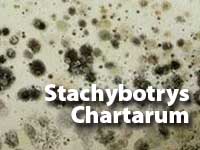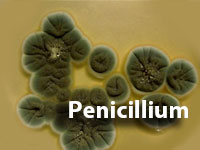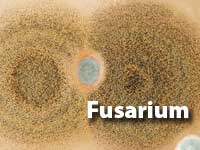MOULD TESTING,REMEDIATION AND REMOVAL

EnviroDoctors break down the 5 MAIN SPECIES of Mould.





Stachybotrys Chartarum - Toxic black mould or black mould is a name commonly used for Stachybotrys Chartarum. It is one of the most infamous toxic moulds because it can grow in houses and is extremely dangerous to humans. Stachybotrys is known as a toxic mould because it produces toxins called mycotoxins. These spores, if ingested or inhaled, can cause a range of unpleasant and even dangerous symptoms in humans. The most common black mould symptoms and health effects are associated with a respiratory response. Black mould can kill. If you're exposed for long enough, black mould spores can shut down your organs, incapacitate your immune system, and damage your brain -- resulting in death.
Cladosporium – species produce olive-green to brown or black colonies, and have dark-pigmented conidia that are formed in simple or branching chains. Many species of Cladosporium are commonly found on living and dead plant material.
Penicillium – There are about 200 different species of Penicillium. They are commonly called the blue or green moulds because they produce enormous quantities of greenish, bluish or yellowish spores which give them their characteristic colours. The antibiotic, penicillin, is made from the fungus Penicillium chrysogenum. Penicillium causes food spoilage, and is an indicator organism for dampness indoors.
Fusarium - Fusarium mould can be a highly dangerous mould that typically affects soil and plants. It can cause a range of infections in humans and has even been used as an agent of biological warfare. There are many varieties of this mould, and it can appear pale or brightly coloured, with a cottony surface. The species can cause infections of human eyes, skin or nails and may also cause systemic infections in individuals with weak immune system.
Aspergillus - These moulds have been classified by some authorities as being toxigenic or pathogenic and instant action is required when they appear in occupied indoor environments. Species of Aspergillus have been found in damp walls, wallpaper, PVC/paper wall covering, gypsum board, floor, carpet and mattress dust, upholstered-furniture dust, acrylic paint, leather, HVAC insulations, filters and fans, humidifier water, shoes, leather, bird droppings, potted plant soil, plastic and decomposing wood.
The first task in keeping mould at bay is discovering what areas and conditions might encourage mould growth. Moulds are pervasive everywhere, and thrive in wet conditions. How does mould grow? Mould grows best when moisture and humidity are present. When mould spores encounter a damp surface most advantageous for fungal growth, they can begin to grow and thrive. In Winnipeg, this threat is increased every spring due to the potential of basement flooding caused by a quick melt of the snow pack.
Potential Mould Causes
Many different things can cause a household mould problem. Typically things that cause mould growth involve too much moisture in the home, since all types of mould require moisture in order to grow and spread. Conditions that are often causes of mould in a household include:
- Flooding
- A leaky roof or window frames
- Leaving windows open when it rains
- Leaky or broken pipes
- Leaky sinks, tubs or toilets
- Leaky washing machines or dishwashers
- Poorly ventilated bathrooms (simply turning on the exhaust fan or opening a window a bit when showering can help with this)
- Poorly ventilated laundry rooms
- Damp basements
MOULD SYMPTOMS:
What are the Potential Health Risks of Mould?
- Eye, nose and throat irritation
- Coughing and phlegm build-up
- Wheezing and shortness of breath
- Symptoms of asthma
- Allergic reactions
- Respiratory illness
- Breathing problems among adults, children and pets
If you suspect that you or your family's health is being affected by mould, talk to your health care provider as soon as possible.
People respond to mould in different ways, depending upon the amount of exposure and the person's overall health. Some people are more vulnerable to the effects of mould than others. This includes children, the elderly and those with a weakened immune system or other medical conditions, such as asthma, severe allergies or other respiratory conditions.
Mould often grows in places where it’s not easily spotted, like inside walls, under floors, in attics, and inside heating and air conditioning ducts. If you smell a musty odour in your home, you probably have mould growing somewhere. If your home has been flooded or had extensive water damage of any kind, you almost certainly have some mould, even if you don’t see any. Even a small water leak can cause mould to grow. If you, a family member, or a pet have any of the symptoms described above and you’re not sure of the cause, it’s possible you have a mould problem.
The discovery of mould … in any building is not pleasant and the first step we recommend is an air quality testing to determine the mould spore levels in your home or place of work.
Enviro Doctors provides the mould testing at absolutely no cost.
Depending on the results of that test, we can then take the necessary steps to remove these hazardous materials. Due to the risks associated with mould, removal requires a highly trained remediation team to ensure the health and safety of everyone.
Our Technicians …carry Inspection Cleaning and Restoration Certification (IICRC) , and follow the IICRC/ANSI S520 Standard for Professional Mould Remediation: 2015 the most current standards available. We follow the Manitoba guidelines for the investigation, assessment and remediation of mould in workplaces, developed by Workplace Safety and Health.
Our process … is predicated on the deployment of experienced technicians who have the knowledge and experience to design effective remediation strategies to safely contain and remove mould contamination from homes, commercial and industrial buildings. All contaminated materials are carefully bagged, then removed from the property and disposed of properly. Once all contaminated materials have been removed, the area is treated with a proprietary antimicrobial product to kill any remaining mould spores.
Enviro Doctors remediation process utilizes an environmentally-friendly, non-toxic solution that has been developed especially for us in a Winnipeg, Manitoba laboratory.
Cleaning and killing mould is only one part of the remediation process. Proper containment, HEPA (High Efficiency Particulate Air) vacuuming and air filtration are also necessary, as indicated by the IICRC S520 Guideline. When the application is completed, a HEPA vacuum is used to eliminate the remaining dead spores and restore the environment to a condition 1 status.
The final step is to perform a clearance test (air quality testing) to validate that the remediation project has been successful. Our certified technicians use the appropriate personal protection equipment (PPE) while performing the remediation and follow remediation protocols.
FOR A LIMITED TIME, WE ARE OFFERING THIS POST-TREATMENT TEST AT NO CHARGE. VALUED AT $300, IT IS OUR “FRESH AIR GUARANTEE”.
